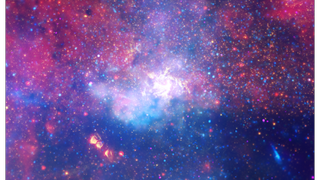News
Science & Astronomy

This image shows invisible infrared and X-ray wavelengths of light that have been translated into visible-light colors.
(Image credit: NASA, ESA, SSC, CXC, STScI)
Ever since astronomers first laid their eyes on the sparkling spiral arms of our home galaxy, the Milky Way, they have wondered what processes might drive the evolution of these massive, star-studded structures. Presumably, those same processes are why we see such a stunning diversity of galactic neighborhoods in the observable universe, which contains an estimated 2 trillion galaxies with unique sizes, shapes and compositions.
So, in an effort to further our understanding of galactic evolution, over 100 astronomers from over 80 institutions around the world have called for the James Webb Space Telescope (JWST) to conduct a multi-epoch, large-area, multi-wavelength survey of the Milky Way’s innermost regions. Decoding the dynamics of the Milky Way’s heart, or Galactic Center (GC), should shed light on what happens in many other galaxies in our universe, too.
While the Milky Way’s Galactic Center is one of the most studied regions in the night sky, a number of its astronomical mysteries persist.
Related: James Webb Space Telescope reveals distances of nearly 200 deep-space galaxies
For instance, scientists wonder, what role does the supermassive black hole sitting in our galaxy’s center, Sagittarius A*, plays in its evolution? Why is our galaxy’s star formation slower than it should be in cold, dark molecular clouds in the area? How do our galaxy’s central star clusters emerge in the first place?
Why the JWST?
“The center of our galaxy is challenging to observe for two reasons,” Adam Ginsburg, an astronomer from the University of Florida who co-authored the white paper, told Space.com.
For one, Ginsburg says, the Galactic Center is full of stars. It’s so dense, in fact, that smaller telescopes struggle to tell one star from another. Plus, our view of the Galactic Center from Earth is obstructed by large clouds of dust.
“JWST solves both of these problems,” Ginsburg explained, “because it’s a big telescope, it has excellent resolution and can separate stars from one another well. And, because it observes in the infrared, it can see through the dust. No other telescope can do both.”
The JWST’s Near-infrared Camera (NIRCam) and its system of filters, which allow astronomers to separate spectra of infrared light into wavelengths emitted by specific materials, makes the observatory uniquely capable of peering through these dense regions of dust. To the unaided eye, those regions just look like dark voids because we can only see visible light wavelengths, blocked by those dust veils. Infrared wavelengths, however, can cross over to the other side, ultimately hitting the JWST’s detectors.
The JWST is also capable of making observations in longer wavelengths of infrared light, which it uses to observe galaxies in the early universe. The light from these galaxies has stretched, or “redshifted” due to the continued expansion of the universe, where their light waves are moving towards the red end of the electromagnetic spectrum (where longer wavelengths are categorized). The process is also known as the Doppler Effect. Infrared is longer in wavelength and lower in energy than visible light, making it invisible to humans.
But even still, one telescope wouldn’t capture the whole picture — which is why the team’s proposal suggests using a number of other telescopes (old and new) to support the JWST’s findings.
According to the paper, the survey is planned to include the Atacama Large Millimeter Array (ALMA) and the Hubble Space Telescope, which are both already in service, as well as future telescopes like the Roman Space Telescope, the European Space Observatory’s Extremely Large Telescope, and Japan’s JASMINE astrometry satellite. The proposed multi-epoch survey would collect data on the Galactic Center at one, five and 10 year intervals.

This image shows invisible infrared and X-ray wavelengths of light that have been translated into visible-light colors. (Image credit: NASA, ESA, SSC, CXC, STScI)
What could we learn?
One of the biggest unresolved questions about the Milky Way surrounds how its black hole, Sgr. A*, affected our home galaxy’s evolution.
Astronomers already know that massive, galactic black holes like this one grow mostly by feeding on gas that surrounds the holes themselves in plate-like shapes known as accretion disks. Thus, because the presence of such gas is also a necessary ingredient for star formation, its reasonable to infer a relationship between the growth history of Sgr A*, and the rate of star formation in the Galactic Center. The proposed multi-epoch observations of the Galactic Center should give astronomers a solid idea of how many stars are forming, and therefore the rate of growth of Sgr. A*.
Active black holes emit large amounts of electromagnetic radiation, but Sgr A* appears to be relatively quiet on this front, suggesting it isn’t consuming large volumes of material. Astronomers refer to Sgr A* as a ‘quiescent’ black hole, which means it is basically dormant — a clue in the story.
“Sgr. A* is a quiescent black hole and appears to have acquired most of its mass in the past,” Rainer Schödel, an astronomer from the Instituto de Astrofisica de Andalucia in Spain and first author of the paper, told Space.com.
Ginsburg explains the survey could help astronomers get better estimates of something called the Initial Mass Function (IMF) too, which is the relative number of big to small stars that form. The function tells astronomers how much light star populations produce. This is important in studies of galaxies too far away for astronomers to see individual stars.
“The IMF is tricky to measure, though, because the brightest stars go supernova in a very short time, so they’re not around for long enough to measure. The Galactic Center gives us a nice opportunity to beat this problem because it contains many stars of all masses. It is also a different enough environment than the solar neighborhood that we learn something new about how to apply star formation rules to other galaxies,” he says.
What are the hurdles?
“JWST is an extremely competitive telescope, with what may be the highest oversubscription rate of any telescope made — astronomers are asking for a lot more time than is available,” Ginsburg said.
When astronomers make a proposal to use the JWST, a panel of experts convenes to assess the relevant science. However, there are rules that say if you’re on a proposal, or if you would benefit, then you cannot evaluate the proposal (for good reason). This creates a problem for the community that studies the Galactic Center, as almost all astronomers who study this region want to participate in the JWST Galactic Center surveying program.
That leaves nobody with the specific knowledge required on the topic to fairly review the proposal. It was therefore important to show the astronomy community that there is broad consensus on the need for such a survey,” says Ginsburg.
The Milky Way’s Galactic Center is the only galactic core we can observe where each star can be investigated individually. And the more we learn about our galaxy, the more we will learn about how other galaxies evolve throughout the cosmos.
Schödel, Ginsburg, and the other authors want to take us on a journey from galactic suburbia to the city center, where a bustling metropolis, full of mystery, awaits.
A study on the proposal can be viewed on the pre-print server arXiv. It was released online in October.
Join our Space Forums to keep talking space on the latest missions, night sky and more! And if you have a news tip, correction or comment, let us know at: [email protected].
Breaking space news, the latest updates on rocket launches, skywatching events and more!
Conor Feehly is a New Zealand-based science writer. He has earned a master’s in science communication from the University of Otago, Dunedin. His writing has appeared in Cosmos Magazine, Discover Magazine and ScienceAlert. His writing largely covers topics relating to neuroscience and psychology, although he also enjoys writing about a number of scientific subjects ranging from astrophysics to archaeology.
>>> Read full article>>>
Copyright for syndicated content belongs to the linked Source : Space.com – https://www.space.com/james-webb-space-telescope-milky-way-heart-mystery































